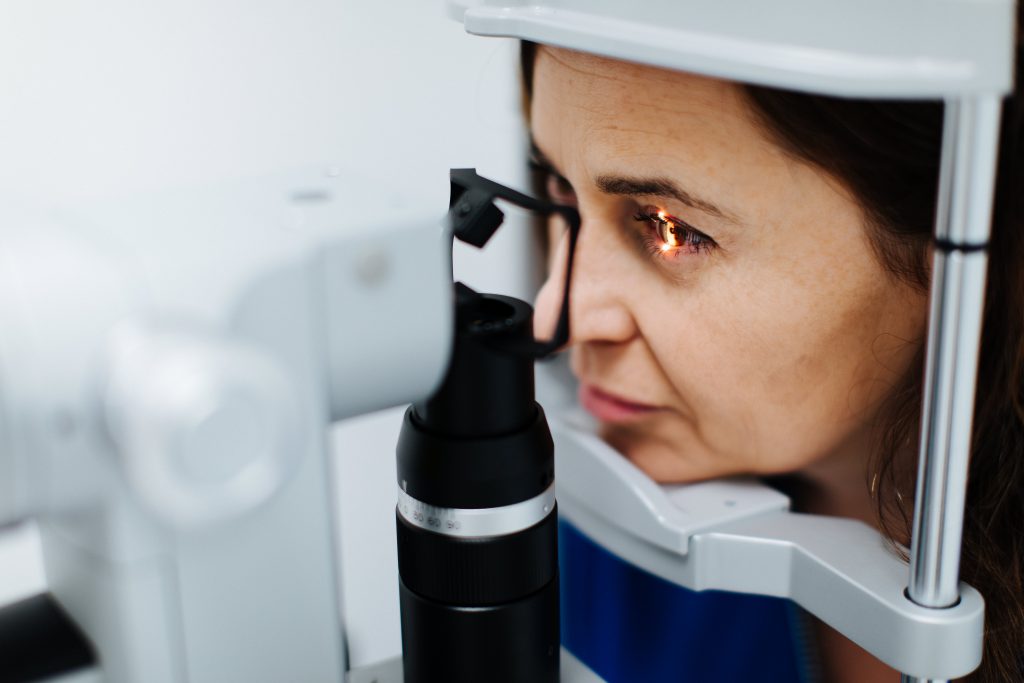Refrakcyjna wymiana soczewki
Czy wiesz, że możesz widzieć dobrze na każda odległość, bez względu na to ile masz lat?
Korekcja wady wzroku do wszystkich odległości jednocześnie
Brak zaćmy w przyszłości
Brak okularów korekcyjnych do końca życia
Poprawa jakości życia
Ochrona UV dzięki filtrom światła niebieskiego

Dla kogo odpowiedni będzie taki zabieg?
Jeśli wada wzroku nie pozwala na korekcję za pomocą zabiegów laserowych i Pacjent ma powyżej 40-45 lat, metoda refrakcyjnej wymiany soczewki może okazać się najwłaściwsza. Za pomocą tej metody możemy usunąć dowolną liczbę dioptrii.
Korzyści z zabiegu odniosą Pacjenci, którzy chcą pozbyć się okularów, z wadą wzroku:
- nadwzrocznością,
- krótkowzrocznością,
- astygmatyzmem.
Najczęściej kwalifikowane są osoby ze starczowzrocznością (prezbiopią), które muszą używać okularów do czytania.
W przypadku Pacjentów, u których występują początkowe zmiany zaćmowe, czyli zmętnienie własnej soczewki lub pojawiła się już starczowzroczność, preferowanym wyborem jest właśnie refrakcyjna wymiana soczewki.

Rodzaje soczewek w refrakcyjnej wymianie soczewki oka.
W przypadku refrakcyjnej wymiany soczewki, stosowane są implanty wieloogniskowe lub wieloogniskowe toryczne. Dzięki temu Pacjenci mogą całkowicie zrezygnować ze stosowania korekcji okularowej. Za pomocą zaawansowanych soczewek wewnątrzgałkowych, możliwa jest korekcja dowolnej liczby dioptrii a Pacjent będzie widział ostro na wszystkich odległościach: bliskiej, dalekiej a także pośredniej.
Soczewki wewnątrzgałkowe wieloogniskowe
Korygują wzrok w wielu punktach ogniskowania. Przywracają Pacjentom pełny zakres widzenia: dali, bliży i odległości pośredniej, ale nie korygują astygmatyzmu.
Soczewki dodatkowo wyposażone są w filtr żółty* odcinający światło niebieskie oraz mają budowę asferyczną* – poprawiającą jakość odwzorowania obrazu.
Toryczne soczewki wewnątrzgałkowe wieloogniskowe
Posiadają takie same zalety jak soczewki wieloogniskowe, jednak dzięki swojej budowie torycznej, przeznaczone są dla Pacjentów którzy zmagają się z astygmatyzmem. Osoby, które w przeszłości miały trudności z akceptacją korekcji cylindrycznej w okularach, bez obaw mogą zdecydować się na wszczepienie soczewki torycznej, ponieważ efekt poprawy ostrości wzroku jest natychmiastowy i trwały. Po zabiegu uzyskuje się znakomitą ostrość wzroku. Soczewki również wyposażone są w filtr żółty odcinający światło niebieskie oraz mają budowę asferyczną.
* Filtr żółty
Ma za zadanie filtrowanie światła niebieskiego, którego nadmiar ma niekorzystny wpływ na warstwę barwnikową siatkówki i może prowadzić do zwyrodnienia plamki żółtej – AMD. Jego właściwości filtrujące odpowiadają naturalnej soczewce ludzkiej w wieku około 30 lat.
* Soczewka asferyczna
Redukcja aberracji sferycznych, pozwalają na uzyskanie znacznie lepszego kontrastu widzenia, zwłaszcza podczas niesprzyjających warunków świetlnych: we mgle, w szarudze jesiennej, w nocy, przy nagłym oświetleniu (np. światłami aut jadących w przeciwnym kierunku).
AcrySof® IQ Vivity ™
To wysoce zaawansowana soczewka wewnątrzgałkowa o zwiększonej głębi ostrości i szerokim zakresie widzenia. Wykonana jest z hydrofobowego materiału AcrySof®, posiada filtr UV i filtr światła niebieskiego, które chronią oczy przed szkodliwym promieniowaniem.
Soczewka Vivity™ należy do kategorii soczewek EDOF (Extended Depth of Focus)
o wydłużonej ogniskowej. Oznacza to, że znajduje się pomiędzy soczewkami wieloogniskowymi oferującymi duży zakres widzenia a soczewkami jednoogniskowymi, które zwykle stosowane są do dali.
Pacjenci po zabiegu wszczepienia soczewki Vivity™ otrzymują rozszerzony zakres widzenia – od dali, przez odległości pośrednie, do funkcjonalnego widzenia bliży.
Dodatkową zaletą jest brak efektów takich jak rozbłyski czy efekt halo.
Asferyczna konstrukcja soczewki IOL AcrySof® IQ Vivity™ pozwala na uzyskanie lepszej jakości obrazu. Nieznacznie uniesiona, lekko wypukła powierzchnia podzielona na dwie strefy, zapewnia szerszy zakres ogniskowania.
AcrySof® IQ Vivity™ IOL jest idealnym rozwiązaniem dla:
- Pacjentów, którzy nie kwalifikują się do wszczepienia soczewki wieloogniskowej, ale chcą pozbyć się ograniczeń związanych ze stosowaniem korekcji okularowej i uzyskać lepsze, funkcjonalne widzenie niż w przypadku soczewki jednoogniskowej.
- Kierowców którzy chcą uniknąć ryzyka wystąpienia niepożądanych zjawisk świetlnych po zmroku.
- Osób spędzających wiele godzin przed monitorem komputera, dla których ważne jest widzenie bliży.
- Dla wszystkich osób, które oczekują osiągnięcia lepszego kontrastu w stosunku do soczewek wieloogniskowych.
Na czym polega refrakcyjna wymiana soczewki?
Refrakcyjna wymiana soczewki polega na usunięciu naturalnej soczewki Pacjenta i wszczepieniu w jej miejsce nowoczesnego implantu wewnątrzgałkowego o mocy dopasowanej do rozmiarów oka pacjenta. Zabieg ten jest zbliżony do operacji zaćmy, w której zmętniałą soczewkę Pacjenta zastępujemy sztuczną. W przypadku refrakcyjny wymiany soczewki, usuwamy przejrzystą soczewkę własną Pacjenta a wszczepiony zaawansowany implant, zmienia moc optyczną i wyrównuje wadę wzroku.
Po wybraniu odpowiedniej, indywidualnie dopasowanej do potrzeb Pacjenta soczewki, ustalany zostaje termin zabiegu. Odbywa się on w znieczuleniu miejscowym za pomocą kropli. W trakcie zabiegu, Pacjent jest pod opieką personelu medycznego i pozostaje w stałym kontakcie z operatorem.
Zabieg wykonywany jest w znieczuleniu miejscowym kroplowym i jest całkowicie bezbolesny. Pacjent w trakcie zabiegu pozostaje w stałym kontakcie z personelem medycznym i jest w pełni świadomy. Sztuczne soczewki są wykonane z materiału tolerowanego przez tkanki oka – tzw. biokompatybilnego. Soczewki wszczepialne pochłaniają promienie UV i minimalizują odblaski. Powikłania chirurgii refrakcyjnej oka w chwili obecnej zdarzają się bardzo rzadko i obarczone są stosunkowo niskim ryzykiem operacyjnym, ze względu na rodzaj zastosowanego znieczulenia miejscowego.


Przygotowanie do zabiegu wszczepienia sztucznej soczewki
Przed zabiegiem refrakcyjnej wymiany soczewki, Pacjent musi wykonać specjalistyczne badanie kwalifikacyjne, które pomoże wykryć rodzaj i stopień zaawansowania schorzeń oczu. Na podstawie tego badania, lekarz dobiera odpowiednią moc oraz rodzaj soczewki. Oprócz badania okulistycznego wskazane jest wykonanie badań laboratoryjnych, tj. oznaczenie grupy krwi, morfologia, układ krzepnięcia.
W związku z tym, że zabieg wykonywany jest w znieczuleniu miejscowym, jedynie ciężki stan Pacjenta jest przeciwwskazaniem do wykonania wszczepu.
Stan Pacjenta po zabiegu wszczepienia soczewki wewnątrzgałkowej
Rekonwalescencja po zabiegu nie trwa długo i już po kilku tygodniach można wrócić do normalnego funkcjonowania oraz wszystkich swoich ulubionych aktywności. Należy jednak pamiętać, że proces ten jest bardzo indywidualny i każdy pacjent będzie przechodził go inaczej.
Poniżej zamieszczamy najważniejsze kwestię o których należy pamiętać w okresie rekonwalescencji:

- Przestrzegaj kalendarza wizyt kontrolnych oraz wszystkich zaleceń lekarza, w szczególności tych, dotyczących stosowania kropli.
- W okresie 4 tygodni po zabiegu, unikaj gwałtownego pochylanie głowy w dół lub nagłego unoszenia w górę, nie noś ciężkich przedmiotów oraz ogranicz wysiłek fizyczny. Podczas zakładania obuwia, nie schylaj się, używaj do pomocy stołeczka.
- Nie mruż, nie zaciskaj i nie pocieraj oczu.
- W okresie 2 tygodni po zabiegu unikaj samodzielnego mycia głowy, aby zabezpieczyć oczy przed dostaniem się do oczu piany.
- Pamiętaj o stosowaniu okularów przeciwsłonecznych wychodząc z domu. Ochronią one Twoje oczy przed szkodliwym promieniowaniem UV, oraz wiatrem.

Refrakcyjna wymiana soczewki
Cena badań kwalifikacyjnych
399,-
Cena zabiegu
od 8500,-

